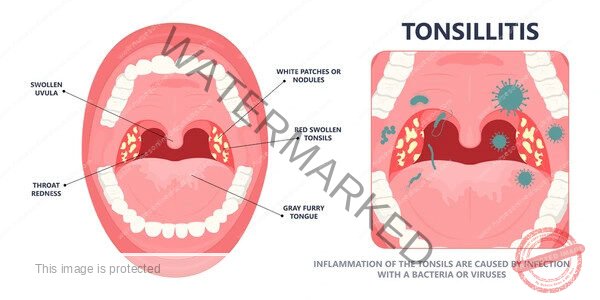Surgical Conditions of the Neck
Subtopic:
TONSILLITIS
The tonsils are integral components of the lymphatic system, playing a role in combating infections. Interestingly, the removal of tonsils does not appear to heighten susceptibility to infection.
Located at the back of the throat, the two masses of tissue known as tonsils function as filters, trapping pathogens that might otherwise enter the airways and cause infection. They also generate antibodies to fight off infections. However, sometimes the tonsils themselves become infected. When overwhelmed by bacteria or viruses, they swell and become inflamed, a condition termed tonsillitis.

Tonsillitis is a common ailment, particularly among children. This condition can manifest occasionally or recur frequently.
Causes and Symptoms of Tonsillitis
Both bacterial and viral infections can trigger tonsillitis. A frequent bacterial culprit is Streptococcus (strep) bacteria. Other common causes include:
Adenoviruses
Influenza virus
Parainfluenza viruses
Enteroviruses
Herpes simplex virus
The primary symptoms of tonsillitis involve inflammation and swelling of the tonsils, which can sometimes be severe enough to obstruct the airways. Other symptoms include:
Throat pain or tenderness
Redness of the tonsils
A white or yellow coating on the tonsils
Painful blisters or ulcers on the throat
Headache
Loss of appetite
Ear pain
Difficulty swallowing or breathing through the mouth
Swollen glands in the neck or jaw area
Fever, chills
Bad breath
In children, additional symptoms may include:
Nausea
Vomiting
Abdominal pain
Drooling
Diagnosis
To ascertain the cause of tonsillitis, a healthcare provider may conduct a rapid strep test or a throat swab culture.
A laboratory test can identify a bacterial infection. A viral infection will not be detected by these tests, but it may be presumed if the bacterial test yields a negative result. In certain instances, the physical findings alone may be sufficiently indicative to diagnose a probable bacterial infection.
Monospot test: A blood test that can detect specific antibodies, aiding in confirming if a person’s symptoms are attributable to mononucleosis.
Treatment
Antibiotics: Such as penicillins (e.g., amoxicillin, ampicillin) and cephalosporins (e.g., ceftriaxone) may be prescribed.
Anti-inflammatory drugs: Like prednisolone, can also be administered.
Painkillers: For managing severe pain.
Abscess drainage: A peritonsillar abscess typically requires puncture with a needle to allow the infection to drain and facilitate healing.
Tonsillectomy: In cases where tonsils are excessively large or recurrently infected, surgical removal may be deemed necessary.
Complications
Inflammation or swelling of the tonsils resulting from frequent or persistent (chronic) tonsillitis can lead to complications such as:
Difficulty breathing
Disrupted breathing during sleep (obstructive sleep apnea)
Infection that spreads deeply into surrounding tissue (tonsillar cellulitis)
Infection that results in a collection of pus behind a tonsil (peritonsillar abscess)
Prevention
The pathogens responsible for viral and bacterial tonsillitis are contagious. Therefore, the most effective prevention strategy is to practice good hygiene. Teach children to:
Wash their hands thoroughly and frequently, especially after using the toilet and before eating.
Avoid sharing food, drinking glasses, water bottles, or utensils.
Replace their toothbrush after being diagnosed with tonsillitis.
To help prevent the spread of a bacterial or viral infection to others, consider the following:
Keep the child at home when they are ill.
Consult a doctor to determine when it is appropriate for the child to return to school.
Teach the child to cough or sneeze into a tissue or, if a tissue is unavailable, into their elbow.
Instruct the child to wash their hands after sneezing or coughing.
THYRODITIS
Thyroiditis is an inflammation (not an infection) of the thyroid gland.
Hashimoto’s disease is a condition in which your immune system attacks your thyroid, Inflammation from Hashimoto’s disease, also known as chronic lymphocytic thyroiditis, often leads to an underactive thyroid gland (hypothyroidism).
Hashimoto’s disease is the most common cause of hypothyroidism.
Treatment of Hashimoto’s disease with thyroid hormone replacement usually is
simple and effective.
Signs and symptoms, causes, and treatment refer to hypothyroidism.
Related Topics
Get in Touch
(+256) 790 036 252
(+256) 748 324 644
Info@nursesonlinediscussion.com
Kampala ,Uganda
© 2025 Nurses online discussion. All Rights Reserved Design & Developed by Opensigma.co

